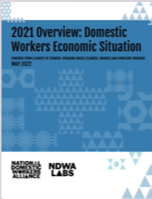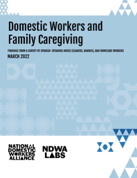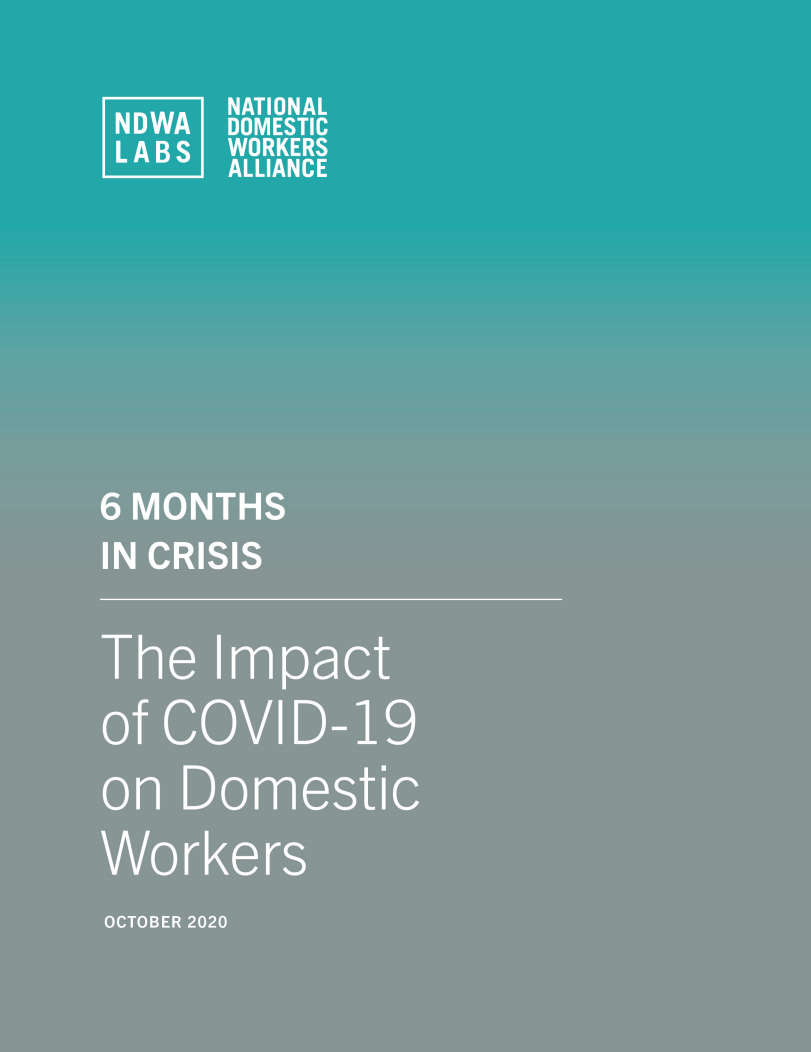Publications
NDWA Labs regularly shares findings from La Alianza’s weekly survey of domestic workers.
Latest Publications
DOMESTIC WORKERS ECONOMIC SITUATION REPORT March 2024.
Joblessness among domestic worker respondents decreased to 15% in March. The wage distribution continued to improve during the first quarter of 2024. Full Report
DOMESTIC WORKERS ECONOMIC SITUATION REPORT February 2024.
Joblessness among domestic worker respondents decreased to 19% in February. Respondents experienced improved economic security. Full Report
DOMESTIC WORKERS ECONOMIC SITUATION REPORT
NDWA Labs’ monthly findings on the economic situation of domestic workers are released on the same day as the US Bureau of Labor Statistics monthly Jobs Report. Based on weekly surveys with thousands of Spanish-speaking domestic workers across the country, these reports cover jobs, wages and food and housing security.
| March 2024 | Joblessness among domestic worker respondents decreased to 15% in March. The wage distribution continued to improve during the first quarter of 2024. |
| February 2024 | Joblessness among domestic worker respondents decreased to 19% in February. Respondents experienced improved economic security. |
| January 2024 | Joblessness among domestic worker respondents was at 20% in January. Respondents faced increased food scarcity and housing insecurity. |
| December 2023 | Joblessness among domestic worker respondents was at 21% in December. Nearly six in ten respondents reported facing difficulty affording expenses in the fourth quarter of 2023. |
| November 2023 | Joblessness among domestic worker respondents was at 20% in November. Respondents faced increased food scarcity. |
| October 2023 | Joblessness among domestic worker respondents was at 13% in October. Respondents faced increased economic insecurity. |
| September 2023 | Joblessness among domestic worker respondents decreased to 17% in September. Eight in ten respondents reported food scarcity during the third quarter of the year. |
| August 2023 | Joblessness increased to 19% in August. Respondents faced increased difficulty affording regular household expenses. |
| July 2023 | Joblessness increased to 18% in July. Housing insecurity increased this month. |
| June 2023 | Joblessness decreased notably during the second quarter. 16% of domestic worker respondents were jobless on average in the second quarter of 2023, compared with 21% in the first quarter. |
| May 2023 | Joblessness decreased to 17% in May. More than six in ten (63%) domestic worker respondents were underemployed. |
| April 2023 | Joblessness decreased to 18% in April. Six in ten domestic workers reported earning less than $15 per hour. expenses during the first quarter of 2023. |
| March 2023 | Joblessness for domestic worker respondents remained at 21% in March. More than half of respondents struggled to afford regular household expenses during the first quarter of 2023. |
| February 2023 | Joblessness for domestic worker respondents decreased slightly to 21% in February. Joblessness remains higher than during the second half of 2022. |
| January 2023 | Joblessness for domestic worker respondents increased to 22% in January 2023. Housing insecurity was higher in January than at any point in the last year. |
| December 2022 | Joblessness for domestic worker respondents remained at 19% in the fourth quarter of 2022. 7 in 10 respondents who worked in December wanted more work hours. |
| November 2022 | Joblessness for domestic worker respondents increased to 18% in November. Housing insecurity increased in November for survey respondents. |
| October 2022 | Joblessness for domestic worker respondents decreased to 16% in October. Joblessness remains higher than its pre-pandemic rate of 9%. |
| August 2022 | Joblessness for domestic worker respondents remained at 19% in August. Joblessness remains higher than its pre-pandemic rate of 9%. |
| July 2022 | Joblessness for domestic worker respondents decreased to 19% in July. Joblessness remains higher than its pre-pandemic rate of 9%. |
| June 2022 | Joblessness for domestic worker respondents decreased to 20% in June. Nearly 7 in 10 workers earned less than $15 per hour this month. |
| May 2022 | Joblessness for domestic worker respondents increased to 21% in May. 7 in 10 domestic worker respondents earned less than $15 per hour in May. |
| April 2022 | Joblessness for domestic worker respondents decreased to 19% in April. But 7 in 10 workers reported wanting more work hours than they had. |
| March 2022 | Joblessness for domestic worker respondents decreased to 20% in March. More than 7 in 10 workers earned less than $15 per hour this month. |
| February 2022 | Joblessness for domestic worker respondents decreased to 22% in February. This is more than double the 9% who reported having no jobs before COVID-19. |
| January 2022 | Joblessness for domestic worker respondents increased to 26% in January. Nearly 8 in 10 respondents faced food insecurity in January 2022. |
| December 2021 | 20% of domestic worker respondents were jobless in December. Nearly 3 in 4 respondents faced food insecurity in the last quarter of 2021. |
| November 2021 | 23% of domestic worker respondents were out of work in November. 7 in 10 workers experienced some level of food insecurity. |
| October 2021 | Joblessness for domestic workers decreased in October, with 22% of respondents out of work. Underemployment remains high, with 3 in 4 respondents saying they wanted to work additional hours. |
| September 2021 | Domestic workers' joblessness remained at 28% during September. More than 3 in 4 domestic worker respondents experienced food insecurity in the third quarter of 2021. |
| August 2021 | Joblessness for domestic workers remained high in August, with 28% of respondents out of work. More than 3 in 4 domestic worker respondents experienced food insecurity. |
| July 2021 | Domestic workers' joblessness ticked up in July, with 29% of respondents out of work. Of domestic workers who could not pay their July rent, 58% owe two or more months of rent. |
| June 2021 | Domestic workers’ joblessness remained at 25% in June. Unemployment in the second quarter was much lower than in the second quarter of 2020. |
| May 2021 | Domestic workers’ joblessness continues to decrease but remains at 25%. More than 8 in 10 respondents who had work in May are underemployed. |
| April 2021 | Domestic workers’ joblessness continues to decrease but remains at nearly 30%. 9 in 10 surveyed domestic workers earn $15 or less per hour. |
| March 2021 | Domestic workers continue to face high unemployment, with some improvement compared to January and February. 9 in 10 surveyed domestic workers earn $15 or less/hour. |
| February 2021 | Domestic workers continue to face high unemployment and underemployment, with some improvement compared to January. 9 in 10 surveyed domestic workers earn $15 or less/hour. |
| January 2021 | Domestic workers continue to face high unemployment and underemployment. |
DOMESTIC WORKERS' MONKEYPOX CONCERNS (SEPTEMBER 2022)
In August 2022, we asked workers about their level of knowledge and concerns regarding the spread of monkeypox. This report provides our main findings.
2021 Overview: Domestic Workers Economic Situation (May 2022)
Starting in 2021, we released a monthly Economic Situation report on the same day as the Bureau of Labor Statistics’ Jobs report release. We share an overview of our learnings from monthly Domestic Worker Economic Situation Reports throughout 2021.
The share of jobless respondents declined gradually throughout 2021. However, by the end of 2021, joblessness for domestic worker respondents was still more than twice the rate of joblessness before COVID.
DOMESTIC WORKERS AND FAMILY CAREGIVING (MARCH 2022)
In February 2022, NDWA Labs asked workers about their responsibilities and experiences as family caregivers and how that may have impacted their work.
Most domestic workers are struggling to balance family and work responsibilities. The vast majority of surveyed domestic workers have parenting responsibilities. And most domestic worker respondents told us it was difficult to find care.
DOMESTIC WORKER ACCESS TO THE COVID-19 VACCINE
From March through October 2021, NDWA Labs regularly surveyed domestic workers regarding their access to the vaccine to prevent COVID-19 and their intent to receive the vaccine. We wanted to know if domestic workers who are eligible and willing to get vaccinated had access, and what barriers they faced. Below are findings on domestic worker access to the COVID-19 vaccine:
| October 2021 | 90% of surveyed domestic workers report having received at least one COVID-19 vaccine dose. Over 9 months of surveying, the reported vaccination rate increased from 4% to 90%. |
| August 2021 | 84% of surveyed domestic workers report having received at least one COVID-19 vaccine dose. 72% of respondents say their 12-18 year old children have received the vaccine. |
| June 2021 | 73% of surveyed domestic workers report having received at least one COVID-19 vaccine dose. Unvaccinated domestic workers lack time off work to get vaccinated and to recover from possible side effects. |
| May 2021 | 71% of surveyed domestic workers report having received at least one COVID-19 vaccine dose. 8 in 10 unvaccinated domestic workers intend to receive the vaccine; 2 in 10 do not know how to schedule an appointment. |
| April 2021 | 34% of surveyed domestic workers report having received at least one COVID-19 vaccine dose. 9 out of 10 intend to receive the vaccine; only 28% of those who tried to get an appointment were successful. |
| March 2021 | Surveyed Latina domestic workers report difficulty accessing the COVID-19 vaccine. 9 out of 10 intend to receive the vaccine; less than 12% of those who tried to get an appointment were successful. |
REPORT: 6 MONTHS IN CRISIS: THE IMPACT OF COVID-19 ON DOMESTIC WORKERS. (OCTOBER 2020)
In March of 2020, NDWA Labs began surveying thousands of Spanish-speaking domestic workers to learn how the pandemic was affecting them. This report shares findings from six months of research -- 25 weekly surveys -- covering everything from employment and income to parenting challenges and access to government benefits and relief. More than 20,000 domestic workers from at least 48 U.S states, D.C., and Puerto Rico responded to surveys.
Findings include:
By late March, more than 90% of workers lost jobs due to COVID-19.
Prior to the pandemic, 25% of workers earned between $0-300 in their best week. During the pandemic that number has jumped to 78%.
Workers are earning lower average hourly wages than before COVID-19.
The percentage of workers without any jobs is still four times the percentage before COVID-19.
Between two and three percent of respondents worked 31 to 40 hours per week during the pandemic, compared to 33% before COVID-19.
REPORT: CORONAVIRUS' ECONOMIC IMPACT ON DOMESTIC WORKERS. (APRIL 2020)
Since March 13, 2020 NDWA Labs conducted weekly surveys with subscribers of La Alianza. This report is the results from the third survey, conducted between March 27-30, with 12,153 respondents, and the fourth survey, conducted between April 3-6, with 16,617 respondents.
Findings include:
72% of respondents reported having no jobs for the week beginning 4/6/2020.
80% of respondents with a high volume of work (more than 10 jobs per week) either had no work for the following week, or had lost at least half of their jobs for the following week.
94% report that coronavirus-related cancellations were by their client, rather than by them. And of those respondents, 70% say they don’t know if their clients will give them their job back after the pandemic.




